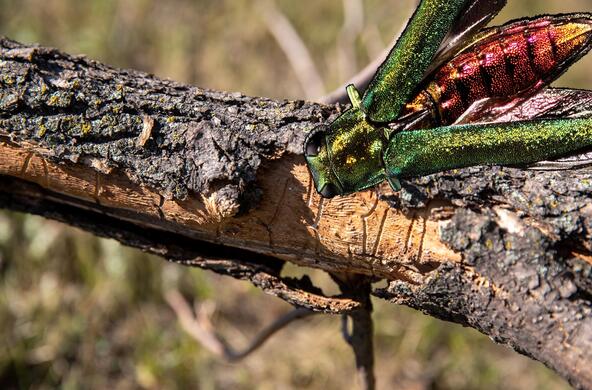Imported forest pests are one of the most destructive threats facing US trees. Dying trees result in loss of wildlife habitat, diminished ecological services – such as cooling and carbon storage – and costly removal fees. Homeowners and municipalities are left footing most of the bill, with total costs exceeding 4.5 billion dollars annually.
Many recent imported pests, such as the Asian long-horned beetle and Emerald ash borer, share a common arrival story. They entered the US as stowaways in imported wood pallets or packing materials – unintentional byproducts of the boom in international trade.

Since 2005, there have been international measures in place to reduce the transfer of insects on wood packaging materials. They have successfully decreased US infestation rates by 36-52 percent. Even so, an estimated 13,000 infested shipments still enter the country each year.
Minimizing insect infestation of wood shipping materials is essential to protecting forests, both in the US and abroad. Additional measures would have an impact on the US forest products industry. Shipping pallets are an important market for low-grade wood; some 40% of US hardwood production is converted to wood packaging materials.
A new report by the Hubbard Brook Research Foundation distills a recent workshop among forest stakeholders in New England, a region that has been particularly hard-hit by invasive pests. Landowners, foresters, pallet manufacturers, conservation practitioners, researchers, and staff of state and federal agencies convened to share perspectives and strategize collective efforts to turn the tide on imported forest pests.

Solid wood shipping pallets make overseas travel easy for boring insects, which burrow into the wood then emerge with offloaded goods. Credit: Wikipedia.
Cary Institute forest ecologist Gary Lovett was a workshop convener and a co-author on the report. He explains, “Most regional discussions and actions about forest pests and diseases focus attention on reducing spread across states. The Hubbard Brook roundtable took a different approach, focusing on preventing invasions in the first place.”
The roundtable gave stakeholders an opportunity to discuss current science on invasive forest pests, pressures faced by the wood products industry, relevant state and federal regulations, and ways in which stakeholders can work together to prevent new imported forest pests.
Recommendations are captured in the report, Invasive Pests and the Future of New England Forests and Forest Products. Avenues for action identified include government action, voluntary action by companies, trade associations, and product purchasers, and public outreach and engagement.
Suggested government actions include: increasing import inspections, raising penalties for noncompliant shipments, building capacity to implement existing regulations on wood packing materials, releasing government statistics on imports and pest outbreaks, and creating new regulations for pallet disposal within the US.
Among the voluntary actions discussed were having large wholesale retailers, such as Amazon, Walmart, and Target, include pest-free packaging as part of their sustainability plans and creating a third-party program to certify ‘forest friendly’ shipping materials.
The report also highlights audiences and messages for outreach and education efforts. Key messages include: supporting government investment in monitoring and research, identifying infestation sources without casting blame, encouraging pest-free shipping, and communicating the cost of invasive pests to land managers and property owners.

Al Robertson, secretary for the Vermont Woodlands Association, participated in the roundtable. “The opportunity to discuss resource management goals, the latest science, and related policy among a variety of stakeholders is so valuable to accomplishing long-term forest conservation. Everyone at the table faces distinct challenges, but we also have insights and experiences that, when shared, can help advance solutions.”
Sarah Garlick of the Hubbard Brook Research Foundation, also a workshop convener and report co-author, concludes: “Though the problem of invasive pests is complex, meaningful action to reduce the risk of infestation is possible. The roundtable underscores the benefit of dialogue across sectors to generate next steps for protecting our forests and forest communities.”
Resources
Invasive Pests and the Future of New England Forests and Forest Products






